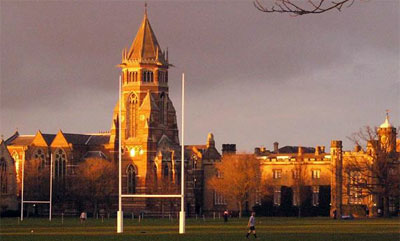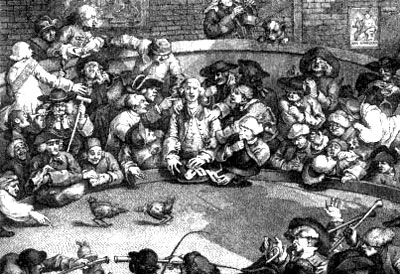Origins
of the game
Two years
before the irascible Duke of Wellington
[1] scored his
final victory over Napoleon at the Battle of Waterloo in
Belgium, young Matthew Bloxam entered Rugby School. It is
a cliché that Waterloo was in fact won on the playing
fields of Eton, England, attesting to the vigorous and
barely contained mayhem practised at the time on the
sports fields of the English public schools. Sixty-four
years later Bloxam wrote his recollections of the game of
football as played at Rugby in his times. These games
consisted of selected teams of twenty or so, to which
others might attach themselves as they saw fit, not
dissimilar to a form of
football known as caid quite common in Ireland at
that time. He remembered William Webb Ellis, a boy ‘with
no lack of assurance,’ whose time at Rugby overlapped with
his. It was this boy who allegedly broke the rule on
handling the ball. According to Bloxham, on one occasion
in 1823, on catching the ball, Ellis did not retire to
take his kick, but rather, ‘with a fine disregard for the
rules of football,’ ran forward with the ball in his
hands, towards the opposite goal. If a junior boy had done
this, wrote Bloxam, ‘he would probably have received more
kicks than commendations’. This in time was to become the
apocryphal account of the origin of the game. ‘It is an
attractively subversive story, impossible to prove beyond
doubt’ (Richards 2007: 24).
The game
was adopted by other public schools as ‘Rugby football
with some exceptions’ and inevitably, as the British
Empire spread to many parts of the world, its
administrators and army officers brought the game with
them. In 1871 the English Rugby Football Union was formed,
and the laws were codified as they were to apply wherever
the game was played. Scotland, Ireland and Wales followed
suit in 1873, 1874 [2] and 1880 respectively. For almost a
century the game was strictly an amateur game.
The schism
which led to the creation of the Northern Rugby Football
Union (NRFU) in Yorkshire, England (later to become rugby
league) in 1895 was deep and bitter. The kernel of the
dispute was that some believed that working men should be
compensated for the loss of a day’s or a half-day’s pay,
while others regarded rugby as exclusively a game for
‘gentlemen’, presumably with private means. It took
ninety-nine years and 364 days for the International Rugby
Board to concede the principal of payment for playing, due
in a large degree to the vast amounts of money flowing
into the game from advertising and television, as well as
a drain of players to rugby league.
Introduction to the River Plate
British
games arrived to the River Plate with British citizens who
were involved in trade, rather than with imperial
administration and conquest. Sports clubs served a
valuable social function for immigrants who had little
affinity with bull-fighting or other sports of Spanish
origin.
Rodeo, the
pre-eminent sport of the gauchos, is still popular
and attracts thousands to the spectacle of the domador
(the horse breaker / tamer) in the Prado
Park in Montevideo during Holy Week. A visitor from
Ireland would have been struck by the similarities to the
Royal Dublin Society’s Horse Show,
[3] even in the design
of the exhibition buildings. However, the differences were
more striking. This is a week of wild horses, broken bones
and gauchos in flamboyant costume, with facóns
(long knives) tucked into their belts.
As in
Ireland and Britain during the early nineteenth century,
cock-fighting was prevalent at the time, as a focus for
gambling. Legend has it that many a man gambled his wife’s
honour at these events, certainly not the action of a
gentleman!
Despite
its ancient origin, - it was played at Troy by Achilles
and Patroclus - the gaucho gambling game taba
was frowned upon by the civil authorities and eventually
outlawed. Not dissimilar in concept to ‘Pitch and Toss’,
[4] it is played with the knuckle bone of a cow and
attracted extravagant bets on how the bones might fall. It
remains illegal in Uruguay, except on election-day. The
newly arrived inglés, despite the emphasis on the
Classics in his or her public school education,
would most probably have regarded it as they would have
regarded Pitch and Toss home, a pursuit for corner
boys and wastrels.
The
largest bull-ring in South America was completed at
Colonia del Sacramento in southern Uruguay in 1912, the
same year that bull-fighting was made illegal in the
country, attesting to the decline of the old amusements in
favour of the imported European games and to some
spectacularly bad timing on the part of the promoters.
The
Montevideo Cricket Club (MVCC) illustrates the situation
of the new immigrants well and may serve as a paradigm for
developments in Argentina also. Founded by an inglés
involved in the meat trade as the Victoria Cricket Club in
1842, it withered almost immediately due to the siege of
Montevideo, which began the following year and lasted
until 1851. General Rivera and the Colorado party declared
themselves to be the defenders of liberty and with the
help of Britain and France, fortified the city against
General Manuel Oribe, the Blanco party and their ally, the
dictator Juan Manuel Rosas of Argentina. Giuseppe
Garibaldi, the Italian national hero, was among the
foreign volunteers who came to defend this ‘New Troy’.
Most of the inhabitants of Montevideo were European at
that time, though there was a substantial community of
Afro-Uruguayans. It is doubtful if there was any space for
field games within the walls during those years.
Presumably the traditional games went on as before. The
government was obliged to impose severe duties on imports,
which may explain why the Cricket Club was unable to
import bats, balls and stumps until 1862.
Paradoxically during two decades of war and political
upheaval, British influence and commercial activity
increased in Uruguay. The production of wool expanded
rapidly, in inverse proportion to the decline of cotton
production during the American Civil War. British
investors such as the Drabble Brothers and MacIntyre
developed new production techniques, notably the enclosure
of pastures with barbed wire and the introduction of
British breeds of sheep and cattle. In 1862 the firm
founded by German chemist Justus von Liebig in London, The
Liebig Extract of Meat Company (Lemco) began to produce
their famous meat extract at Fray Bentos.
The
government of Bernardo Berro, from 1860 to 1864,
introduced many liberal reforms, set up a new and strong
currency using the gold standard, and separated the
Catholic Church from state institutions, especially
education.
The MVCC
reappeared under its present name at a meeting in 1861 of
the original founders, at the fashionable Confitería
Oriental in Montevideo. Its objective was to foster all
sports, including rugby, athletics, rowing and football.
Tennis and the use of the velocipede were also later
introduced. |


